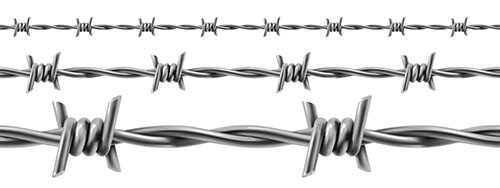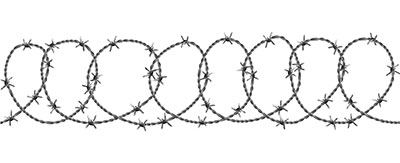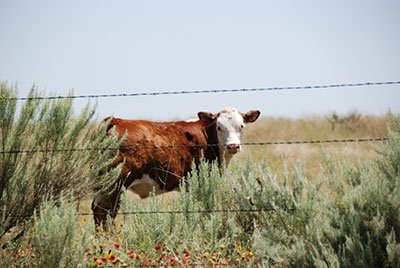If you’re researching fencing options for your property, there are lots of considerations to take into account. You need to consider the type of fencing material that will best meet your needs and budget.
Barbed wire fencing is becoming an increasingly popular option due to its versatility, affordability, and impressive durability—but is it right for you?
In this post, we’ll explore the advantages and disadvantages of barbed wire fences in more detail so you can make an informed decision on whether this type of fence would work well for your property.
Take away key points:
- Barbed wire is one of the top wire solutions for your property needs. However, you can find other wiring solutions if this doesn’t work for you.
- Remember! An electric fence with barbed wire is not possible, you should never electrify the barbed wire, as it is both illegal and dangerous. Also, converting a barbed wire or woven wire fence to an electric fence is not allowed
- You can look for pros and cons to determine whether you will choose it as your top wire system
Table of Contents
- All you must know about barbed wire fences
- What is a barbed wire fence & its purpose?
- History of barbed wire
- All the types of barbed wire
- When should you install a barbed wire?
- Electric fence vs. barbed wire: What works best?
- Razor wire vs. barbed wire: What’s a better solution?
- Alternatives to barbed wire
- Can you electrify barbed wire?
- Pros and cons of the barbed wire
- Frequently Asked Questions
- Is it illegal to put barbed wire around your property?
- What are the 2 types of barbed wire?
- Why did ranchers hate barbed wire?
- What is the best way to roll up barbed wire by hand?
- How dangerous is the barbed wire?
- What happens if you touch the barbed wire?
- Can barbed wire cause tetanus?
- Did barbed wire end the cowboy era?
- Does barbed wire keep coyotes out?
- Summary
All you must know about barbed wire fences
If you need to know more about barbed wire fences, their advantaged/disadvantages, and the different functions they offer, refer to our guide below. We have gathered all the crucial details for you.
What is a barbed wire fence & its purpose?

A barbed wire fence is a type of steel fencing containing sharp points or edges arranged at intervals along the strands. They are commonly used to create boundaries and enclosures for agricultural, security, and other purposes. The good barbed wire fence provides an effective barrier against trespassers, while still allowing air and light to pass through.
The barbs on the wire can be made from various materials such as steel, aluminum, or plastic. The most common type of barbed wire fence is galvanized steel. The wire has a zinc coating to protect it from corrosion. You can also space the barbs on the wire close together or farther apart depending on the purpose of the fence invention.
History of barbed wire
The barbed wire fence has been around since the late 1800s and has been used in many different applications throughout history. The first patent was made in the USA in Ohio, in 1867 by Lucien B. Smith of Kent. However, Joseph Glidden later updated the overall design and created the wiring system that we know today.
The idea of barbed wire as a means for protecting stock and properties had been around for some time before Smith’s patent. In 1868, Michael Kelly presented the basic model of barbed wire, but it wasn’t until Glidden’s improvements that it became widely used across the USA. Barbed wire quickly became an essential tool for ranchers and settlers to protect their herds and maintain their lands in the Old West.
In the 1980s, producers began developing high-tensile barbed wire which mixes steel with a tiny amount of carbon fiber for added strength and durability. This type of barbed wire is still used today to keep stock contained and protect property boundaries.
Barbed wire also brought a speedy end to the era of the open-range cattle industry due to its effectiveness at containing stock on private land and areas.
Within just a few years, many ranchers discovered that they could use barbed wire fences to keep their cattle from straying onto other people’s property or onto public land where they were not allowed to graze. The need for cowboys also decreased during this time, so many believe the barbed wire ended the cowboy era.
The barb wire was originally developed for military use but has since become popular for agricultural and residential uses as well. Today, the barb wire is commonly seen in rural areas where the wire fence provides an effective barrier against animals and intruders alike.
All the types of barbed wire
Barbed wire is a popular choice for security and fencing purposes. There are several types of barbed wire fences available, each with its advantages and disadvantages. The most common types of barbed wire are:
- single-strand,
- double strand,
- single barb,
- double barb,
- conventional twist,
- reverse twist,
- galvanized razor wire,
- cross razor wire,
- flat razor wire,
- straight-type razor wire,
- welded razor wire.
The single-strand barbed wire is the most basic type of barbed wire fence. It consists of a single line of steel wires with sharp points or barbs at regular intervals along the length. This type of fence is relatively easy to install and provides good protection against intruders.
The double-strand wire is an improved version of single-strand barbed wire. It consists of two line modes of steel wires with sharp points/barbs at their regular length. This fence construction provides better protection against intruders than single-strand barbed wire as it is more difficult to climb over or cut through.
These types of fences provide good protection against intruders but require more maintenance than other fencing types. Due to their sharp edges which can easily become damaged or worn down over time, you need to frequently check and maintain the fencing to be optimal.
Conventional twist and reverse twist barbed wires consist of two lines of steel wires twisted together in opposite directions. They create a spiral pattern along the length. These types of fences provide good protection against intruders.
Galvanized razor wire consists of multiple strings of steel wires twisted in a spiral pattern with sharp points or blades. Thanks to the wire spacing and its pattern, the livestock, predators, and other intruders cannot enter your property, or escape it.
Cross razor wire includes several strings combined in an X-shaped pattern. This fence provides excellent protection against intruders as its X-shaped pattern makes it very difficult for them to climb over, jump over, or break through the durable walls of the fencing system. The barbed wire resits animal pressure.
A flat razor has more strands tangled in a flat ribbon shape. This type of barbed wire offers advanced security as no one can enter or escape the fenced areas. So, you can protect your cattle, livestock, gardens, and similar lands.
Straight-type razor uses multiple strands tangled together in a straight line with sharp points or blades at regular intervals along the length. The fence wire is advanced due to its formed design. So, it’s ideal for cattle, livestock, and other animal needs.
Welded razor wire has various strands welded together in various patterns such as circles, squares, etc. They also use sharp points or blades. The fence wire is also ideal for livestock or cattle protection, as predators, such as wild dogs or other intruders cannot enter the walls so easily.
When should you install a barbed wire?
The best time to do so is when you are setting up a new fence. Barbed wire can be used in conjunction with other types of fencing, such as Colorbond steel fence, or on its own.
It is important to ensure that the posts and spacing for the barbed wire are correct and that the wires are 8 inches apart from each other. Additionally, it is important to make sure that the tension of the wires is correct and that all safety precautions are taken during installation.
Electric fence vs. barbed wire: What works best?

An electric fence is an overall better option between barbed wire and electric fences. The electric fence last longer and are more cost-effective than barbed wire, though it depends on the size of the farm and the type of cattle.
Electric fences are less expensive, compared to wood planks. However, they are even cheaper compared to barbed wire, in the panel-by-panel comparison.
An electric fence will also require fewer wires and support posts than a traditional barbed wire fence, making it easier to install and maintain. Additionally, electric fences can be used in combination with other types of fencing such as high-tensile or mesh to create an even stronger barrier.
However, barbed wire can be a good choice for larger farms with large animals like horses or cows because they are more durable than electric fences. Barbed wire is also less likely to be damaged by weather conditions or animals since it doesn’t contain any electrical components.
Overall, both types of fencing have their advantages and disadvantages depending on the size of your farm and the type of livestock you have. If you’re looking for a cheap solution that will last for many years, then an electric fence is probably the best choice for you. On the other hand, if you need a strong barrier that won’t be easily damaged by animals or weather conditions then barbed wire might be the way to go.
Razor wire vs. barbed wire: What’s a better solution?
The razor model is a mesh of steel strips with sharp edges that form a barrier that is difficult for people or animals to pass through. It’s stronger and sturdier than barbed wire and can withstand weather conditions and other external effects. Its sharp edges make it an effective deterrent against intruders, as they can cause serious injuries if touched.
Barbed wire, on the other hand, has far fewer sharp points than the razor model. This means that people or animals are much less likely to sustain serious injuries if they come into contact with it. However, barbed wire is not as effective at preventing intruders from accessing a guarded property as razor type is.
Overall, when it comes to security solutions, the razor is the better choice due to its durability and effectiveness in deterring intruders. It may be more dangerous than barbed wire but its ability to protect your property makes it worth the risk.
Alternatives to barbed wire
You can use different fencing systems instead of barbed wire for the same level of security while being safer.
One option is anti-climb fence spikes, which are designed to prevent people from scaling fences without causing harm. They come in a variety of shapes and sizes, making them suitable for different types of fencing.
Another alternative is a board fence, which is made up of wooden posts placed close together. This type of fence provides an effective barrier against intruders while also allowing wildlife to pass through easily.
Woven wire systems are another option, as they provide a strong barrier while still allowing some visibility.
High-tensile wires are also an effective choice, as they are more reliable than traditional barbed wire and can be used in areas with extreme weather conditions. They cannot bend so easily, creating ideal barriers for high winds and other areas.
Cable fencing is another alternative, offering good security without the danger posed by barbed wire. These fences consist of metal cables stretched between posts and can be used in combination with other types of fencing for added protection.
Finally, electric fences provide an effective deterrent against intruders. These constructions work by delivering a mild shock when touched, making them an ideal choice for protecting property or from predators or trespassers.
Can you electrify barbed wire?
No, the electric barbed wire fence is extremely dangerous, so it is not possible at all.
Electrifying barbed wire is dangerous as animals/people could get trapped and be hit by shock sessions when struggling to free themselves.
The law currently applies to the electrification of the barbed wire itself, so it is still legal to offset a plain wire electric fence from a barbed wire fence.
Barbed wire should never be used for an electric fence for animal or stock control. If an animal or stock becomes entangled in the barbed wire, it could cause even more damage due to the electric shock.
The best way to beef up an old barbed wire fence is to use an offset electric fence instead of trying to electrify the existing barbed or woven wire. It is also illegal to electrify barbed wire, but an offset electrified wire on a barbed wire fence can be disastrous for wildlife.
Therefore, you mustn’t run electric wires in conjunction with barb wires, use copper wires to connect ground rods to fencers or tighten high-tensile wires too tightly when installing your electric system.
Pros and cons of the barbed wire

Here are the pros and cons of using barbed wire:
Pros
– Cost-effective – Barbed wire is relatively inexpensive compared to other fencing materials.
– Durable – Barbed wire can withstand harsh weather conditions and last for many years.
– Easy to install – Barbed wire is easy to install, making it a great choice for those who don’t have the time or resources to hire a professional.
Cons
– Can be dangerous – Barbed wire can cause serious injury if not handled properly.
– Unattractive – The sharp edges of barbed wire can make it an eyesore in certain areas.
– Maintenance – Barbed wire requires regular maintenance to keep it in good condition.
Frequently Asked Questions
Is it illegal to put barbed wire around your property?
No, it is legal to place the barbed wire around your property, but you must ensure the system will not harm innocent pedestrians, interfere with other’s property, or cause any harm or violate one’s rights and safety standards.
What are the 2 types of barbed wire?
The main two types include high-tensile wire and soft/mild steel wire.
Why did ranchers hate barbed wire?
The ranchers hated the wire as their stocks were severely injured, and prone to different infections.
What is the best way to roll up barbed wire by hand?
You should make a roll around two feet in diameter, and roll it hand over hand. You must keep it tight. Also, try not to roll more than you can handle.
How dangerous is the barbed wire?
The wire is dangerous and causes different severe injuries to your skin and underlying tissue.
What happens if you touch the barbed wire?
If you touch the barbed wire, it will rupture your skin or perforate it.
Can barbed wire cause tetanus?
Yes, if you get severely injured by the fence, including puncture wounds or cuts. The wire poses a threat of infection with tetanus. You could read more information here.
Did barbed wire end the cowboy era?
Yes, the barbed wire ended the cowboy era, according to the National Archives. As the manufacturers at American West produced more wiring systems, the wide open space became less open, and less spacious, so the cowboy at the open range wire was not needed anymore.
Does barbed wire keep coyotes out?
No, the barbed wire is not an effective solution for coyotes, as they are intelligent. The system might make them more aggressive and might jump over it easily.
Summary
Having barbed wire up around your property is a great way to deter intruders. However, other options may be better suited for your situation.
Electricity should never be combined with barbed wires as it is both dangerous and illegal to do so.
It’s important to remember though that relying solely on the barbed wire may not lead to the most reliable safety measures. Consider all of your options before making a final decision.
